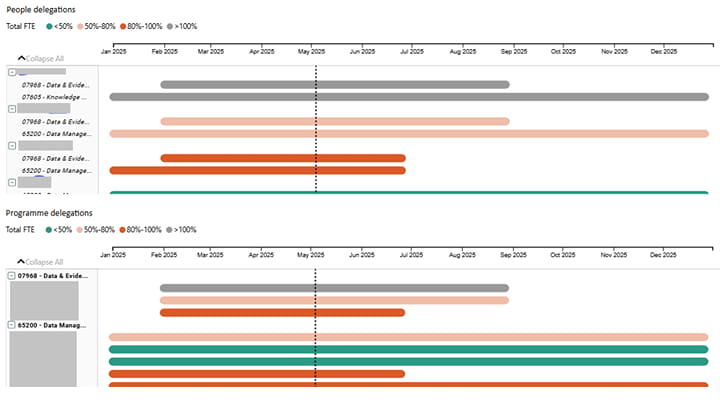Case studies: strategic workforce planning
How public service agencies are using strategic workforce planning to help forecast demand and supply for individuals, roles and skills.
Workforce planning — Ministry of Social Development
The Ministry of Social Development (MSD) is working on combining industry standards with agency-specific competencies to design a comprehensive workforce planning model.
Designing a planning model
To understand the workforce demands of the future, the MSD Practice and Capability Development team is designing a workforce planning model, where both demand and supply are expressed in consistent terms (using the SFIA framework) with a focus on industry skills and competencies specific to the organisation.
Organisation specific skills are aligned to IT services and cover existing and future IT systems and technology shifts.
The benefits of using the model
Although still in development, the framework is already helping align delivery demands with existing capability. MSD expect it will be critical for future workforce planning.
Together with MSD’s Technology Strategy and Learning and Development framework, the model will provide a comprehensive platform to ensure the organisational workforce stays ahead of the curve and is prepared for their ever-evolving delivery demands.
Modelling kaimahi supply and demand — Ministry for the Environment
Like many agencies, the Ministry for the Environment (MfE) has found it challenging to forecast demand at the level of the individual, role or skill. Workforce planning typically operated on a short horizon, primarily driven by the funding cycle.
Mapping demand
In MfE developed a Demand Mapping system (DMS) to capture forward demand for staff. This was by role in the business planning phase (financial year to ) and by individual kaimahi (staff) for resource and cost allocation.
Some teams have used the DMS for the business planning round (financial year to ) and the intent is that the whole Ministry uses it for business planning in the to financial year.
In the DMS, known demand is forecast against existing projects and services (anything with an associated cost centre). Then proposed future work is added, and the planning and performance team can model different scenarios to align effort to outcomes and strategic objectives. Any gap between the supply (as recorded in the HRIS) and demand (as recorded in DMS) tells the workforce planning team what resources and skills will be needed and when, enabling MfE to shift towards a proactive workforce planning approach.
Linking forecast demand to individual kaimahi skills profiles and roles enables agile workforce allocation, because MfE can identify and forward-allocate existing staff from other areas to planned work. This speeds resourcing of projects and reduces MfE’s recruitment burden.

Detailed description of the image
The chart compares projected workforce requirements over a given period, showing anticipated growth, stability or reduction of FTE in different functions. The functions are:
- Cloud Services
- Data management and reporting
- Information security, risk and assurance
- IT operations
- IT PMO
- Strategy and architecture.
The benefits of using DMS
The primary benefit is wider — the DMS approach provides MfE with a forecast of both project and BAU service activity. This surfaces ‘hidden’ work and enables MfE to accurately forecast resource demand across all its work and for all its people.
MfE can see how the approach might be applied more broadly. For example, by the public service forecasting demand and coordinating training and recruitment across the public service.
Services focus to support digital workforce planning — Ministry for the Environment
The Ministry for the Environment’s (MfE) Digital Transformation programme ran from until . In MfE started planning for its IT and digital services post-transformation. At that time MfE employed around 1200 people including around 35 roles in the IT and digital team.
Developing a service catalogue
The first step was to develop an IT and digital service catalogue to support workforce planning.
MfE indexed these services to the skills and roles in the SFIA framework, recording which skills applied to which roles. A lot of this kind of mapping had already been done in the UK (Digital, Data and Technology — DDaT) and Australia (Australian Public Service — APS) and MfE borrowed heavily from their experience.
Forecasting demand
Once the services were mapped out, MfE started to look at demand. Where known, explicit metrics were used, for example, tickets or requests per month, or FTE dedicated to that service. Often, MfE had to estimate (or guess) but once they had estimates they could then test and refine them.
This was easy for the more explicit service-based parts of the business, but a challenge in the project and operations spaces because that work varied significantly, so it took several passes to get ‘right’.
The IT and digital service catalogue and resource forecast was enough to define the staff needs for each function and enabled MfE to estimate the service impact of resource constraints at a very granular level. This proved very useful when planning the resource profile for the Operating Model Review post the election.
The key outcome here was that the IT functions could provide evidence about the requirement for every resource requested.

Detailed description of the image
A chart that shows a clear breakdown of how personnel are assigned. It links forecast demand to staff skill profiles and roles. The chart shows the percentage of FTE over time for each skill profile.

